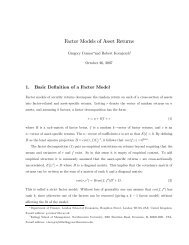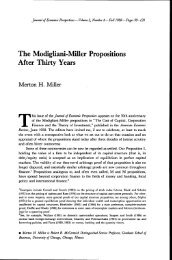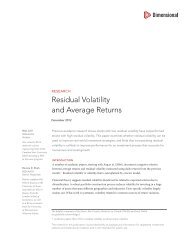Campbell, John Y, Jens Hilscher and Jan Szilagyi, 2005.
Campbell, John Y, Jens Hilscher and Jan Szilagyi, 2005.
Campbell, John Y, Jens Hilscher and Jan Szilagyi, 2005.
You also want an ePaper? Increase the reach of your titles
YUMPU automatically turns print PDFs into web optimized ePapers that Google loves.
st<strong>and</strong>ard deviation of almost 40%. The returns on distressed stocks are also positivelyskewed, both at the portfolio level <strong>and</strong> particularly at the individual stocklevel.Distressed stocks are much smaller than safe stocks. The value-weighted averagesize of the 5% safest stocks, reported in the table, is over 16 times larger than thevalue-weighted average size of the 5% most distressed stocks, <strong>and</strong> the equal-weightedsize is about 9 times larger. Market-book ratios are high at both extremes of thefailure risk distribution, <strong>and</strong> lower in the middle. This implies that distressed stockshave the market-book ratios of growth stocks, but the factor loadings of value stocks,since they load positively on the Fama-French value factor.Thewidespreadinfirm characteristics across the failure risk distribution suggeststhe possibility that the apparent underperformance of distressed stocks results fromtheir characteristics rather than from financial distress per se. For example, it couldbe the case that extremely small stocks underperform in a manner that is not capturedby the Fama-French three-factor model. To explore this possibility, in Table 7 wedouble-sort stocks, first on size using NYSE quintile breakpoints, <strong>and</strong> then on failurerisk. In Table 8 we double-sort, first on the book-market ratio using NYSE quintilebreakpoints,<strong>and</strong>thenonfailurerisk.Table 7 shows that distressed stocks underperform whether they are small stocksor large stocks. The underperformance is, however, considerably stronger amongsmall stocks. The average return difference between the safest <strong>and</strong> most distressedquintiles is three times larger when the stocks are in the smallest quintile as opposedto the largest quintile. If we correct for risk using the Fama-French three-factormodel, the alpha difference between the safest <strong>and</strong> most distressed quintiles is about50% greater in the smallest quintile than in the largest quintile. The table also showsthat in this sample period, there is only a weak size effect among safe stocks, <strong>and</strong>among distressed stocks large stocks outperform small stocks.Table 8 shows that distressed stocks underperform whether they are growth stocksor value stocks. The raw underperformance is more extreme <strong>and</strong> statistically significantamong growth stocks, but this difference disappears when we correct for riskusing the Fama-French three-factor model. The value effect is absent in the safeststocks, similar to a result reported by Griffin <strong>and</strong> Lemmon (2002) using Ohlson’s O-score to proxy for financial distress. However this result may result from differencesin three-factor loadings, as it largely disappears when we correct for risk using thethree-factor model.21





